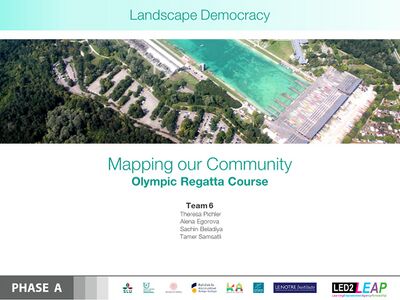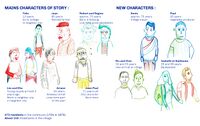LED2LEAP 2020 - Freising Team 6
>>>back to working groups overview
| Area | Freising | |
| Place | Olympic Regatta Course | |
| Country | Germany | |
| Topics | Landscape Democracy | |
| Author(s) | Theresa Pichler, Alena Egorova, Sachin Beladiya, Tamer Samsatli | |

| ||
Landscape Democracy Rationale
- Why do you think this community context is relevant from a landscape democracy perspective? What is your hypothesis considering the landscape democracy challenges?
- Format: 3-4 sentences
Location and scope
- You can edit this map with the map editor
- Next to showing us where you are, you may also use this map to localise different focus themes of your community
Phase A: Mapping your Community
Welcome to our community and its landscape
- OLYMPIC REGATTA COURSE is a rowing venue situated in Oberschleißheim near München in Germany. It was built for the rowing and canoeing events of the 1972 Summer Olympics, since then the site has been in active use ever since – for the daily training sessions of the home based Watersport Clubs as well as for big national and international events like the German Championship or the World Rowing Championship in 2007.
- The area is also a popular destination for excursions of hikers, cyclers and inline skaters who can enjoy a day out on the paths around the lake.
- The regatta course area is part of the two communities München and Oberschleißheim.There is mostly agricultural use and forest around the lake. Also it is part of „blue connection“ between Isar and Amper - as you can see in the sketch.
- graphical representations based on our PPT presentation
Groups of actors and stakeholders in our community
- we are showing the actor groups in our area, their visibility and needs
- There are strong & weak relationships and shared interests between the actor groups
- graphical representations based on our PPT presentation
Relationships between our actors and groups
- there are strong & weak relationships and shared interests between different actor groups
- for example tourist groups and restaurants have a strong relationship. On the other hand there is a weak relationship between tourist groups and researchers
- shared interests you can see between locals and farmers
- graphical representations based on our PPT presentation
Summary of your learnings from the transnational discussion panel on April 22
On April 22 you will present the PPT version of this first assignment to other seminar groups working in other geographical community contexts. Please give here a short summary of your learnings during this presentation, for example:
- importance of community participation
- Other analytical approaches
- time management is an essential component of presentations
- Other representation styles
- we received Constructive comments on our presentation
Theory reflection
- Insurgent Public Space
public space is where identities, meanings, and social relationships in cities are produced, codified, and maintained, it is through insurgent public space that alternative identities, meanings, and relationships can be nurtured, articulated, and enacted. better understand such everyday and not-so-everyday making of public space that defies the conventional rules, regulations, and wisdom. It focuses on alternative spaces, activities, expressions, and relationships that have emerged in response to opportunities, constraints, and transformation in contemporary society.
- Storytelling, a model of and a model for planning
It was obvious that old stories could be the base that we should keep an eye on and try to build our new vision by taking into consideration that the development of our stories. The development of any future landscapes must stick to past stories and put forward a proper study for the existance situation of any rigion.
References
- Header graphic: https://www.leistungszentrum-muenchen.de/ueber-uns/anfahrtsplan/
- Figure 1:https://account.mapbox.com(edited with Photoshop)
- Figure 2: own illustration based on: https://account.mapbox.com
- Figure 3: https://www.umweltatlas.bayern.de/mapapps/resources/apps/lfu_natur_ftz/index.html?lang=de(Umweltatlas Bayern)
- Figure 4: https://www.citypopulation.de/en/germany/bayern/
- https://www.citypopulation.de/en/germany/bayern/
- https://en.wikipedia.org/wiki/Oberschlei%C3%9Fheim_Regatta_Course
- 6th LE:NOTRE institute Landscape forum 2017: https://www.landscape-portal.org/
- Own survey
Phase B: Democratic Landscape Analysis and Assessment
The Scene in your Story of Analysis
- Describe your landscape democracy challenge. What is the physical scene, specific description of the landscape? What are the socio-economic and political characteristics of place? Are there any important contextual elements?
- add the corresponding visual from your presentation to the image gallery below
The Actors in your Story of Analysis
- Describe the characters and their role in the story. Are they major or minor characters? Are there any key relationships that need to be defined?
- add the corresponding visual from your presentation to the image gallery below
The Story of Analysis
- Describe the plot of the story and how it plays out.
- add the corresponding visual from your presentation to the image gallery below
- add as many additional images as you like
- Yourcase story2.jpg
add a caption
Reflect on your Story of Analysis
- How did the tools you chose for landscape analysis fit your community? Reflect on the questions: What did you carry? Why did you carry? How did you carry? What remains after you've left? (150 words)
- add the corresponding visual from your presentation to the image gallery below
- Yourcase refelction1.jpg
add a caption
Phase C: Collaborative Visioning and Goal Setting
* template coming
Phase D: Collaborative Design, Transformation and Planning
* template coming
Phase E: Collaborative Design, Transformation and Planning
* template coming
= Phase E: Collaborative Evaluation and Future Agendas * template coming
Process Reflection
- Reflect in your intercultural and interdisciplinary team on the outcomes of your study
- Which limitations were you facing?
- What have you learnt from each other?
- What would you do differently next time?
- You can also use diagrams/visuals
- 250 words text













